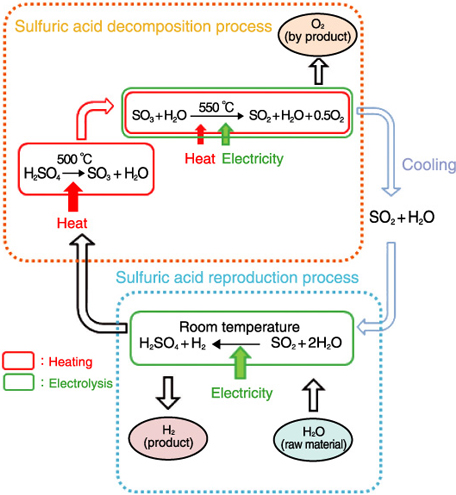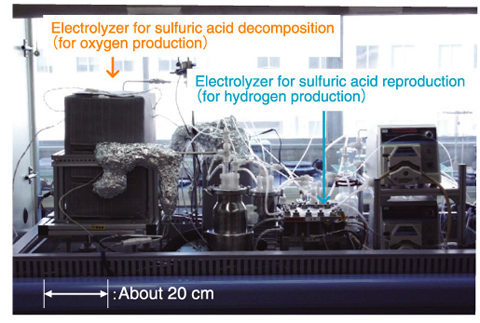
Fig.14-14 Flow of the HHLT process

Fig.14-15 External view of HHLT engineering test apparatus

Fig.14-16 Example of hydrogen production experiment
Hydrogen is anticipated to be a future carbon-free energy carrier. However, at present there is a problem with carbon dioxide emissions during hydrogen production, because industrial hydrogen production uses fossil fuels. It is important to develop a future hydrogen production process without carbon dioxide emissions.
To solve this problem, we are developing a process for producing hydrogen in very large volumes from water using heat and electricity from Fast Breeder Reactors (FBRs). A thermo-chemical process is a process to decompose water chemically using multiple chemical reactions, and is expected to have higher thermal efficiency (namely lower energy consumption) than direct water electrolysis (direct water electrolysis: about 30% → our process: about 44%). A thermo-chemical and electrolytic Hybrid Hydrogen production process in a Lower Temperature range (HHLT) has been invented based on the Westinghouse process, which was developed for high temperature gas cooled reactors. In order to reduce the top end reaction temperature to 500~550 °C, which is the operation temperature of FBRs, the HHLT process employs electrolysis along with thermal decomposition for the gaseous sulfuric acid decomposition step, which previously required a high temperature of over 800 °C. We were the first in the world to achieve hydrogen production using the HHLT process.
The flow of the HHLT process is shown in Fig.14-14. Sulfuric acid is vaporized and decomposed into sulfur trioxide and water vapor, and sulfur trioxide is decomposed into sulfur dioxide and oxygen by electrolysis (sulfuric acid decomposition process). The decomposed sulfur dioxide and water vapor are cooled to room temperature, and sulfuric acid and hydrogen are produced by electrolysis (sulfuric acid reproduction process). We developed a test apparatus to confirm stable hydrogen production using the HHLT process (Fig.14-15), and achieved stable hydrogen production (Fig.14-16). Test results confirmed the stability of the process when the sulfuric acid supply flow rate was varied. Besides, the major equipments will be made of metal for practical implementation, and we evaluated the anti-corrosion performance of the materials under a highly corrosive sulfuric acid environment.